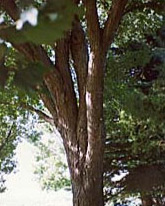Blog
Discover the World of Trees
Trees are some of the most abundant living things on earth. At ArborCare Tree Service Ltd., serving customers across Western Canada, we know that better than most people. Trees not only grace our living spaces, they create the life-giving oxygen by which we survive and nourish thousands of other living species. The elements and compounds which trees create are the source of hundreds of products we consume and use daily—including wood, fruit, and additives.

The most common trees that we see in our area include the Colorado Blue Spruce, White Spruce, American Elm, Siberian Elm, Green Ash, Black Ash, Manitoba Maple (Box Elder), Larch, Bur Oak, Mountain Ash, Apple/Crabapple, Linden, Chokecherry, Birch, Laurel Leaf Willow, Hawthorn, Russian Olive, Scots Pine, Lodgepole Pine, Ponderosa Pine as well as many varieties of Poplar and Aspen trees.
Here are some neat facts about trees that your arborist thinks are worth sharing:
- Over one year, one tree can produce up to 260 pounds of oxygen. If that tree is part of a larger group (say, one acre of trees), that acre can absorb and clean nearly 2.6 tons of Co2 from the atmosphere!
- Trees live longer than any other organism on Earth.
- Trees absorb light (shading) and evaporate water from their leaves, reducing cooling and heating costs. Because they absorb sound, they also are extremely effective noise barriers and cut down on noise pollution. In the summer, a young, leafy tree can cool the same amount of space as two home-sized air conditioners.
- In nearly every culture and religion, trees are regarded as symbolic and spiritual. Visible trees help hospital patients heal more quickly and use fewer painkillers. Tree worship that existed in primitive times has a modern day vestige in the tradition of “knocking on wood” for good luck. It was thought that knocking on a tree could rouse protective spirits asleep in the bark.
- During a year, most trees will create 99% of their living parts from scratch, calling on the carbon from the air, nutrients and water from the soil, and energy from the sunlight to create themselves. Without budging an inch, most trees are completely self-sustaining. Trees don’t generally die from old age, even though the ability to lift water through their trunks decreases with time. Rather, most trees meet their doom through people, insects, or disease. Some trees are more than 4,500 years old – and still growing!
- Trees move water up their trunks through a process called capillary action. Some trees can move water through their trunks at the rate of 150 feet per hour. During a hot summer day, certain trees can suck nearly one ton of water up through their roots.
- As one of the most eco-conscious cities in Canada, Edmonton keeps a running tally of the trees within its borders. To date, there are about 309,000 ornamental trees in the city. As many of these trees grow older, tree removal in Edmonton becomes a necessity. Luckily, the empty spaces are often replaced with saplings. If you live in the city, you can actually request permission to plant a tree on public property!
- Trees planted in Western Canada stand the greatest chance of surviving when they are planted in the spring. It is a good idea to stake the tree while it grows.
- Calgary recently launched an initiative urging its citizens to better take care of the trees that make up their urban forest. One way that trees can better withstand an urban environment is by undergoing tree pruning in Calgary. This procedure helps balance the tree, regulate the nutrients that circulate through its body, and decrease the likelihood of disease or limb breakage.
Thanks for visiting our site and learning about these organisms we share space with. Next time you’re considering planting, pruning or removing trees, we hope you’ll call ArborCare, your preferred arborists in Calgary, Edmonton and Kelowna!
 1-877-444-8733
1-877-444-8733